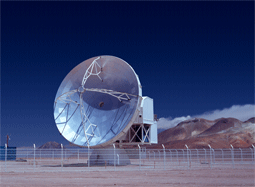Star Search
Air Date: Week of May 5, 2006

The APEX Telescope at Chajnantor (European Southern Observatory)
As scientists around the world rush to find out more about our universe, Living on Earth takes a look at one new telescope in South America. Spectrum Radio’s Jean Kumagai reports on the new Apex Telescope located in the Chilean Andes.
Transcript
CURWOOD: To get a clearer view of the universe, astronomers are pushing the limits of technology – lofting new telescopes into space, burying them deep underground in abandoned mines, and placing them atop some of the world’s highest and most remote mountains. Jean Kumagai recently traveled to the Andes of Chile to see one these extreme telescopes and she has this report.
[DRIVING NOISES]
KUMAGAI: To reach one of the highest telescopes in the world you have to travel up, of course. Up along a rutted dirt road that winds its way to the peak of Cerro Chajnantor, nearly 17 thousand feet above sea level. The higher we climb in our dust-covered pickup, the more the wind howls, and the colder it gets. Soon, tall snowdrifts, the remnants of a recent blizzard, surround us.
[DRIVING SOUNDS]
KUMAGAI: Our destination is the new Atacama Pathfinder Experiment, or APEX, the largest radio telescope in the southern hemisphere. It sits on a rocky plateau near the summit…a giant, shining white dish that looks improbably high-tech against the austere mountain landscape. Kind of like finding a bullet train on the moon. This telescope is big. 39-feet across, and every few minutes, it slowly rotates, depending on which part of the universe astronomers want to observe.

The APEX Telescope at Chajnantor (European Southern Observatory)
NYMAN: It takes two days to go through all the screws. And we did it in weather not too, yeah, very similar to this. So, it was not very pleasant (laughs).
KUMAGAI: Nyman and his colleagues who work at the telescope endure more than just bad weather. The oxygen-poor air leaves many a visitor dizzy and disoriented. Nyman says for some people, it can be life threatening.
NYMAN: …other people when they come up look okay to start with, then their oxygen level drops rapidly until they enter into a stage of shock.
KUMAGAI: But for astronomers, the risk is worth it. APEX is a relatively new breed of telescope, designed to measure energy emitted at millimeter wavelengths which are much longer than visible light waves. Astronomer Karl Menten, the principal investigator here, says APEX is especially useful for studying interstellar clouds--vast expanses of cosmic dust and gas where new stars are born.
MENTON: One of the big mysteries in astronomy is how do exactly stars form? And we try to find that out. To do that we study the initial conditions of star formation. So we observe these dust clouds and the emissions of the dust of the molecules allow us to determine the temperature, the mass, and a lot of other things.
KUMAGAI: Turns out, the only way to peer into the interiors of these clouds is with telescopes like APEX. But you have to site them in a very special place, Menten says. One that’s both high and dry.
MENTEN: At submillimeter wavelengths, your biggest enemy is the earth’s atmosphere. The earth’s atmosphere, even at dry sites, has a lot of water in it. The water very effectively absorbs radiation, particularly at certain special frequencies. So the higher you go, the less water content in the atmosphere, the drier it is.
KUMAGAI: In a few years, an even bigger observatory, called the Atacama Large Millimeter Array, or ALMA will be built along side of APEX. Comprising 50 antennas, all working in tandem, ALMA will be the world’s most sensitive millimeter instrument. When it’s completed in 2012, Menten believes ALMA will yield the final answers to many of the questions of submillimeter astronomy- questions like what exactly happens when an interstellar cloud collapses? And what does the birth of a star look like?
Until ALMA’s arrival, though, Menten says it’s fun to use APEX and start exploring those questions now. For Living on Earth, I’m Jean Kumagai
CURWOOD: Jean Kumagai is a reporter for Spectrum Radio, the broadcast edition of IEEE Spectrum magazine. To find out more about the Apex telescope visit our website, Living on Earth dot org. That’s Living on Earth dot O-R-G.
Links
Living on Earth wants to hear from you!
Living on Earth
62 Calef Highway, Suite 212
Lee, NH 03861
Telephone: 617-287-4121
E-mail: comments@loe.org
Newsletter [Click here]
Donate to Living on Earth!
Living on Earth is an independent media program and relies entirely on contributions from listeners and institutions supporting public service. Please donate now to preserve an independent environmental voice.
NewsletterLiving on Earth offers a weekly delivery of the show's rundown to your mailbox. Sign up for our newsletter today!
 Sailors For The Sea: Be the change you want to sea.
Sailors For The Sea: Be the change you want to sea.
 The Grantham Foundation for the Protection of the Environment: Committed to protecting and improving the health of the global environment.
The Grantham Foundation for the Protection of the Environment: Committed to protecting and improving the health of the global environment.
 Contribute to Living on Earth and receive, as our gift to you, an archival print of one of Mark Seth Lender's extraordinary wildlife photographs. Follow the link to see Mark's current collection of photographs.
Contribute to Living on Earth and receive, as our gift to you, an archival print of one of Mark Seth Lender's extraordinary wildlife photographs. Follow the link to see Mark's current collection of photographs.
 Buy a signed copy of Mark Seth Lender's book Smeagull the Seagull & support Living on Earth
Buy a signed copy of Mark Seth Lender's book Smeagull the Seagull & support Living on Earth

